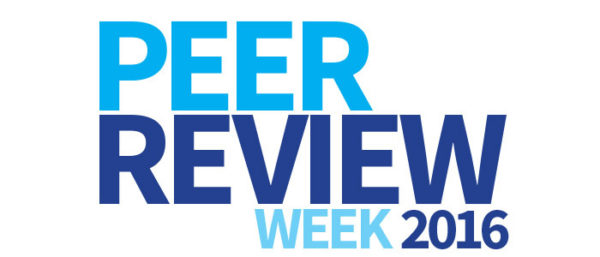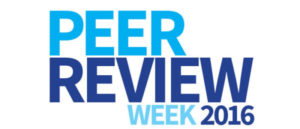 Higher Education Reform
Higher Education Reform Recognition for Peer Review: Who’s Doing What?
To help celebrate Peer Review Week 2016, the steering committee for the commemoration asked the 20+ organisations on the group to tell us how they #recognizereview and what more they hope to do in future. Their responses show a clear understanding of the importance of peer review and a firm commitment to supporting more recognition for review in future.
Tessa Picknett, Executive Director, STM, SAGE Publishing
Peer review is the lynchpin of the scholarly publishing process, relying heavily on the expertise of reviewers around the world. To recognize the vital role that peer reviewers play, SAGE has developed a range of initiatives, including rewarding peer reviewers by enabling free and seamless access to all 950+ journals on the SAGE journals platform for 60 days following submission of a review. In addition, we have established a partnership with Publons to further enable recognition of individual reviewer’s contributions and to improve the peer review process for all stakeholders. We are also delighted to be supporting Publons’ inaugural peer review recognition awards being launched this week.

This post first appeared on the Peer Review Week website and is a culmination of opinions and thoughts from the Peer Review Week organizing committee.
Peer review – like everything in publishing – is constantly evolving, with increasingly innovative developments in online submission systems and open peer review. However, the fundamental role of evaluation, improvement, and selection – by reviewers and editors – continues to be widely endorsed as an essential component of the scholarly communication system. Whilst we continue to focus on mechanisms to make this as transparent, ethical and straightforward as possible, we recognize a need for support and guidance, especially for early careers researchers, and we are driving forward initiatives, and collaborating with others to provide expert support across the globe.
[SAGE Publishing is the parent of Social Science Space.]
Alison O’Connell, Aries Systems
Aries Systems advances peer review recognition by giving journals using Editorial Manager® flexibility to collect the data they need in-workflow, enabling participation in reviewer recognition initiatives downstream. Building this configurability into EM gives journals the control to experiment with emerging recognition services. Journal system administrators can configure the reviewer form to solicit permission to share review data, and can export appropriate review data in the formats required by recognition services, such as Publons.
Looking ahead, we keep abreast of developing needs through our continuous engagement with the community through user group meetings, industry conference participation, and other initiatives, so that when new tools and services emerge, the functionality is already in place to empower editors to explore.
Peter Berkery, Association of American University Presses (AAUP)
Peer review is woven deep into the fabric of AAUP. Our membership guidelines instruct that regular members must meet the editorial criteria of having both a board that certifies the quality of its scholarly publications, and a peer review process that meets a common standard.
The Association’s Admissions & Standards Committee holds applicants to a rigorous standard, reviewing editorial processes undertaken in recent publications for consistency with these standards. Membership in AAUP recognizes the importance of peer review to the scholarly record, and recognizes those nonprofit scholarly publishers who commit to this work—and the editors and reviewers who uphold our standards.
We recently articulated the common standard of peer review quality in monographic publication in Best Practices for Peer Review, which is available under a CC-BY-NC-SA license. It is the (peer-reviewed!) product of a two-year consensus-building effort by the AAUP Acquisitions Editorial Committee.
We expect that the practice of peer review may change in the future—as disciplinary norms shift, and new experiments in the format and delivery of both scholarship and scholarly peer evaluations find successful models. The reason for peer review—to help develop and validate high quality scholarship—will remain, as will its central role in AAUP and in AAUP membership.
Elizabeth Moylan BioMed Central (BMC)
A recent survey of our peer reviewers found they choose to undertake peer review based on their expertise, not on the basis of any expected rewards. However, in keeping with the theme of Peer Review Week 2016 over a third of respondents felt that stronger recognition of their work was motivating. Public acknowledgement and certificates were mentioned.
At BMC we recognize reviews in the form of citable acknowledgements. Our open peer review journals also provide recognition to peer reviewers through the publication of their named reports alongside the article. Reviewers for the BMC series of journals can also obtain a discount from the article-processing charges when submitting to the BMC series.
We have recently announced a trial partnership with Publons, so that reviewers can showcase their peer review activity. We also provide support for peer reviewers in the form of ‘how to’ article collections by experts in various types of research methodology and guidance for beginners.
In future, we want to explore ways in which reviewers in general (regardless of peer review model) can be recognized publicly. We’ll also be looking at the free text comments received in our initial survey and sharing – as well as responding to – what we learn.
Bahar Mehmani, Elsevier
Elsevier launched its Reviewer Recognition platform over two years ago, providing reviewers with a personal review profile page in which they can view their Elsevier journal review history and, in a few simple steps, create a public Reviewer Page listing all their peer review activities – including those for other publishers’ titles. Reviewer statuses are awarded based on the number of reviews they have completed for a specific journal. Since the launch of the platform, more than 450,000 reviewer individual profiles with a “status” have been created. Reviewers receive the encrypted link to their personal profile every time they complete a review for a title. They can download a variety of certificates based on the number of reviews they submit to a journal and take advantage of other perks such as discounts on Elsevier bookstore and WebShop author services. Furthermore, our journal editors can select reviewers based on the quality of their reviews, nominating them for a “Certificate of Excellence,” which complements the certificates based on frequency of review. Editors can also publish their list of nominated reviewers on their journal homepage as well. For Elsevier, this is just the beginning of an ever-expanding road toward recognizing reviewers.
Ruth Francis, F1000
At F1000Research we do post-publication peer review, which allows us to give credit to reviewers in many ways. Reviewers’ names and affiliations are published along with their full report alongside the paper which means that their contribution to the article is clear and the reports become an integral part of the article and the scientific discussion around it. Because the whole process is open and transparent, reviewers can see how the author responds to their comments and how they revise their article. In this way, referees are recognized as a part of the whole publishing process. We give a DOI to the report so it can be cited in its own right, and referees can also add their review to their ORCID profile to give visibility to their professional process.
In the future we hope to see reviews recognized as a qualitative measure of the article itself and used by readers, funders and institutes to evaluate the quality of the research. We would like to see many others adopting more open peer review and reviews used in an evaluative way.
Kristen Overstreet, International Society of Managing and Technical Editors (ISMTE)
ISMTE is all about peer review. Conversations at meetings and on the member discussion forum, and several EON articles, indicate awareness of the importance of reviewers’ contributions. But has ISMTE given enough attention to the methods of recognizing reviewers? Unfortunately, the answer is no; however, I already see change brought about by the theme of this year’s Peer Review Week.
Meghan McDevitt, the Editor of EON, has commissioned an article for the October issue on the subject of recognizing reviewers, and the Education Committee is developing an educational resource on rewarding reviewers and editorial board members that will be posted on the ISMTE website (www.ismte.org) soon. Social media posts and discussion forum conversations this week will identify more ideas for how journal editorial offices can recognize and reward the crucial contributions of our reviewers. We also hope to learn how reviewers in other areas, such as grant review, promotion and tenure, etc., are recognized. This could help us identify new methods we have not yet considered.
Peer Review Week 2016 has brought the issue of recognizing reviewers of all types to our attention, and I look forward to the new resources that ISMTE will be able to offer as a result.
Annette Flanagan, JAMA and the JAMA Network
JAMA and The JAMA Network Journals have provided peer reviewers with continuing medical education credit for many years. In addition, the journals publish annual editorials recognizing the contributions of peer reviewers, with a link to lists of the names of peer reviewers who provided peer reviews for the journal in the previous year. See JAMA’s examples here and here.
As an organizer of the International Congress on Peer Review and Scientific Publication along with the BMJ and METRICS, we are interested in seeing new research into incentives and rewards for peer reviewers. Many have been launching new programs and are experimenting with novel ways to incentivize, acknowledge, and credit peer reviewers and peer reviews. We invite those interested in conducting research evaluating the effectiveness of these programs and models for peer reviewers to submit abstracts for the next Peer Review Congress. See topics for suggested research. Abstracts are due February 15, 2017, and the Peer Review Congress will be held September 10-12, 2017, in Chicago.
Pandelis Perakakis, Open Scholar
What is peer review? What is its purpose? How would we redesign it from the ground up to best serve this purpose? From the perspective of what is best for Science, peer review should be a mechanism of validation. Once produced, a scientific work should be exposed to the eyes of the entire scientific community who would collectively decide whether it meets the scientific requirements to become part of the knowledge commons or if it needs further improvements. No assessment of the potential impact of the article is relevant to the peer review process. Peer review should be an open debate to generate consensus about the scientific validity of a given work. In this conceptual framework, reviewers are recognised because they are openly helping improve each other’s work. Reviewers act as co-authors who have an interest in increasing a work’s scientific quality because if they succeed, the work, and their names appearing next to it, will gain more visibility. Open scholar develops and promotes infrastructure that facilitates a model of open peer review, organised around institutional repositories and open archives. Our two flagship projects are the Self-Journals of Science and PeerMod—an open peer review module for open access repositories.
Alice Meadows, ORCID
ORCID’s vision is for all who participate in research, scholarship, and innovation to be uniquely identified and connected with their contributions and affiliations across disciplines, borders, and time. Our peer review functionality, introduced last year, enables organizations to recognize all types of peer review activities – of publications, conference abstracts, grants, promotion and tenure applications, and more. It allows organizations to connect review information to a researcher’s ORCID record (with her/his permission), from where it can also be shared with other organizations if wished.
Several of our publisher members were early adopters of this functionality (American Geophysical Union, eJournal Press, F1000, and Publons), and we are now encouraging more members – from publishing and beyond – to implement it. We believe that adding validated information about peer review activities to ORCID records will help enable more recognition for this important work across all sectors.
Tom Culley, Publons
A Publons profile recognizes your review activities, and demonstrates your commitment and contributions to sound research in your field. Over 80,000 researchers already use our free service to effortlessly track, verify and showcase their reviewing and editorial contributions, in real-time, across all of the world’s journals. Publons provides:
- unique statistics and insights to compare your reviewing behaviour with others
- verified proof of previously hidden contributions to include in promotion and funding applications
- premier reviewer discovery, screening and analysis tools.
Over 1,000 journals from Wiley, SAGE, Springer Nature, Cambridge University Press, The Royal Society and many more will be fully integrated in 2016.
This year, we are launching the Sentinels of Science Awards – the ‘Nobel Prizes’ for peer review – with support from industry heavyweights. We’re excited to be announcing the inaugural recipients at the end of Peer Review Week 2016.
In coming months, Publons is focusing on facilitating training and feedback to reviewers, to elevate the quality of peer review and research. Publons users are also directly contributing research and analysis into peer review that was previously not possible. Our unique, cross-publisher peer review information will be used to assess how peer review is performing globally and the impact it has on research.
Phil Hurst, The Royal Society
The Royal Society recognizes peer review in two main ways. Since its launch two years ago, our ‘objective peer review’ journal, Royal Society Open Science has provided the option to publish peer review information. Two thirds of published authors have opted for this and many reviewers have ‘signed’ their reports.
For the past year, we have integrated our biggest journal, Proceedings B, with Publons. This integration makes it easy for reviewers to opt into including recognition of their work in their Publons profile. A substantial number of reviews have been claimed, the majority through the integration. An added bonus is they can easily add this information to their ORCID profile via Publons. Researchers indicate that peer review is not regarded as an important research output by their institutions at present. However, they are building their profiles of peer review work for when it is recognized.
In the future we want more recognition for reviewers. We intend to extend the opportunities provided by open peer review and our Publons integration to more of our titles and more reviewers. There are potentially many more ways to recognize peer review – we are keen to identify and explore these. We think transparency is important in peer review and believe that reviewers should be recognized for this vital research output.
Stephanie Dawson, ScienceOpen
Open and public, post-publication peer review has been a cornerstone of ScienceOpen since our beginning. We believe that full recognition of peer reviewers’ efforts requires transparency. Therefore, any ScienceOpen member with the required level of expertise can evaluate and review any of 25 million articles with their name and research history available via ORCID. ScienceOpen peer review reports receive a CrossRef DOI to make them citable and trackable for altmetrics. Researchers can add them to their CV, ORCID profile, and website. Making well-written and insightful reviews citable, is an important step towards giving reviewers real credit for their work, and by making reviews open, we can also prevent valuable information from being lost. The context of a researcher’s evaluation – his/her experience, specialties, publications – is important for the reader in assessing a peer review and adds to the context of the research itself. As the volume of publications worldwide continues to grow, new strategies will be needed to support researchers in this evaluation process – both pre- and post-publication. As a major aggregator of information, ScienceOpen will continue to explore ways to open up and understand the context of scholarly research, with peer evaluation of research in all its forms remaining central to that mission.
Amy Bourke-Waite, Springer Nature
At Springer Nature we’re constantly looking to improve our peer review systems, and find new and better ways of recognizing peer reviewers for their hard work. Existing methods of recognition include monetary reward (monographs), and free subscriptions or discounts on Article Processing Charges (articles). But most researchers simply want their name to be acknowledged.
Seventy BioMed Central journals offer open peer review, encouraging transparency and providing a valuable educational resource for future peer reviewers. In the last year, BioMed Central have published over 40,000 open peer review reports, recognizing 24,000 peer reviewers.
Nature Editor in Chief Philip Campbell writes and thanks anyone who reviews three or more papers for the Nature Research portfolio. In 2016 we piloted initiatives including optional publication of peer-reviewer reports in Nature Communications; optional publication of peer-reviewer identities in Nature; optional transfer of peer-reviewer reports and identities from Nature Communications to other selected Springer Nature journals.
This month we’ve started a Publons pilot across 13 of our journals., and we’ll soon be announcing another pilot, experimenting with a new type of recognition. Finally, to all our reviewers everywhere: in case we haven’t said it recently, thank you from the team at Springer Nature.
Verity Warne, Wiley
At Wiley we recognize the integral role that reviewers play in scholarly communications. Researchers spent a huge amount of time reviewing (at least 22 million hours for the top 12 publishers alone in 2013), and we continue to introduce new ways to reward and recognize their invaluable contribution.
Journals across our program show their appreciation for reviewers by offering certificates, book discounts, APC discounts, CME for reviewers, and acknowledgement lists.
This week we are proud to announce that more than 750 Wiley journals are being newly integrated with Publons, allowing reviewers to track, verify, and showcase every review they undertake for participating journals. Reviewers can then use their verified peer review and editorial records in funding and promotion applications.
In our study of reviewer motivations, training and recognition needs last year, we found that researchers strongly believe that reviewing is inadequately acknowledged at present and should carry more weight in their institutions’ evaluation process. Some work has been undertaken in this area (the 2012 Sense About Science’s open letter to HEFCE, and the open letter to the Australian Research Council to name a couple) but we believe more could be done to facilitate debate on this issue with all stakeholders, including funders and research assessment bodies.





















































































